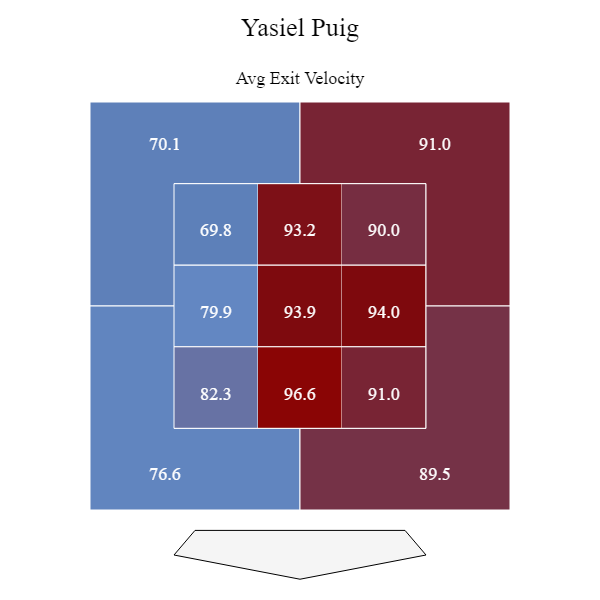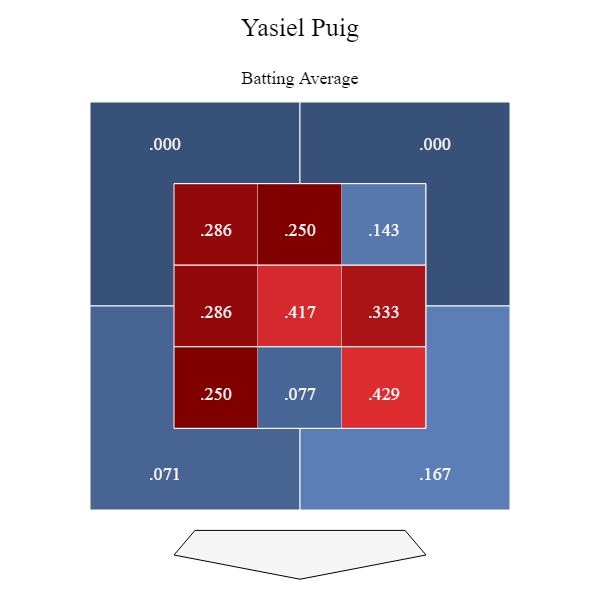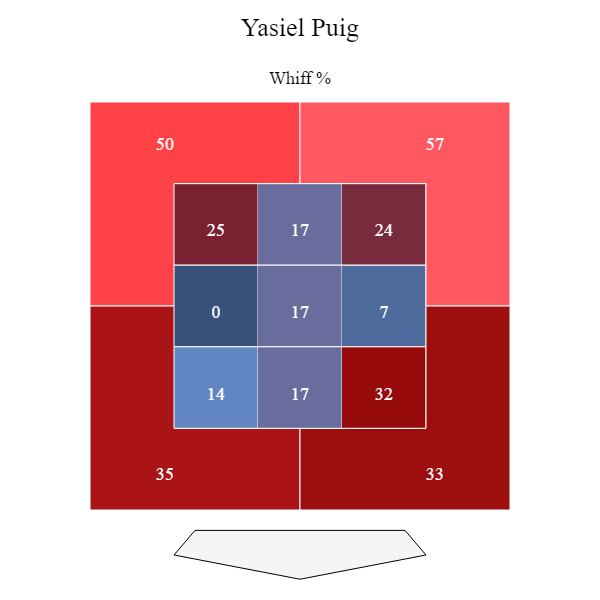(Photo by Adam Davis/Icon Sportswire)
In the bottom of the sixth inning last night, something very perplexing happened during game four of the 2018 World Series. The Los Angeles Dodgers, clinging to a 1-0 lead, had something cooking– Boston Red Sox starter Eduardo Rodriguez, in a very high leverage situation, was slowly coming undone with two outs and two runners on base. Up until that inning, he was pitching pretty well. Yasiel Puig, hitting .298 this postseason with a .191 ISO, comes to the plate. Dispensing with the dramatics, Puig hammered a three-run homer that put LA up 4-0.
In theory, Rodriguez did the right thing. Against left-handed pitching, Puig is not good against fastballs. So bad in fact that he hits somewhere in the neighborhood of .157 with a 24% whiff rate since 2017. Yet these figures are without context, meaning we don’t know what type of sequencing pitchers give Puig to account for this handicap; we only know how he hits the pitch against lefties. I’m sure the pitching coach and catcher are aware of this caveat, right? Anyway, on the surface, it appears that throwing Puig the fastball might be the best way to get the last out of the inning.
But fastballs on all five of the pitches you throw?
Thus far in the postseason, 71% of pitches thrown to Puig have been fastballs. His batting average in this short sample is .323 with a .360 BABIP. Puig’s handled the pitch pretty well, but keep the aforementioned context in mind.
Let’s look at Puig’s 2018 zone charts against southpaws, all pitches considered. First his exit velocity, followed by his batting average and whiff rate.

CHART 1


CHART 3
Puig knows that Rodriguez tops out at 93 MPH (four-seam fastball) and his slowest pitch (slider) averages 85 MPH. Using the ‘hitter’s attention zone’ philosophy, Puig is sitting on a range of 91 MPH to 87 MPH which allows him to compensate for potential speed differentials. Think of it (as Perry Husband describes) as a safety in coverage having to account for two wide receivers on either end of the field. He could cheat to one side or the other but if he guesses the wrong side, he’ll be burned. So he splits the difference (middle of the field) to stay within a reasonable range of coverage for both wideouts.
Here we have pitch one, a 91 MPH four-seam fastball painting the corner up and in, that Puig takes for a strike; good location when looking at Chart 3.
[gfycat data_id=”GreenDistinctBluetonguelizard”]
Pitch two, a 92 MPH four-seamer that narrowly misses the zone up and away; an even better location when reviewing Charts 1 through 3.
[gfycat data_id=”SinfulEasyDrever”]
Pitch three was a 92 MPH four-seamer high and well out of the strike zone while pitch four was a 93 MPH two-seam fastball that rode a break way inside for ball three. Can you see where this is going? You could argue that Rodriguez was trying to fool Puig into thinking he was setting him up for something off-speed or breaking, but Rodriguez threw one slider all game and roughly 80% of the pitches he threw last night were fastballs.
Rodriguez wanting to throw a pitch five strike to Puig instead of trying to get him to chase is curious to me. Chris Taylor was due up next and, despite finishing the game with a .750 OBP, hasn’t had a very good World Series (.167 BA).
So here it is– a 92 MPH two-seam fastball that Puig rocked at 96% of his potential power, complete with the Rodriguez glove slam.
[gfycat data_id=”AgileGreenIntermediateegret”]
Go back and look at the three charts; that pitch was put in the worst possible location and Rodriguez did very little to disrupt Puig’s timing. All of the pitches either in the zone or in the pressure zone (just outside of the strike zone) had less than a 6 EvMPH spread (a max of 4 EvMPH to be precise).
Let’s review the sequence in terms of Effective Velocity (‘unaccounted’ means they are too far out of the zone to measure; throwaway/badly missed pitches):
P1- 91 MPH fastball (96EvMPH)
P2- 92MPH fastball (92EvMPH)
P3- 92MPH fastball (unaccounted)
P4- 93MPH fastball (unaccounted)
P5- 92MPH fastball (92EvMPH)
Puig doesn’t miss middle zone much and the fact that the pitch had very little deceptive movement, Rodriguez essentially delivered the ball on a silver platter. Puig is way too locked in this October to miss that opportunity.
And there you have it. All pitches right in the high-end of Puig’s attention range. Rodriguez couldn’t have made it any easier and it might have cost the Red Sox dearly. There will be all kinds of back and forth about whether manager Alex Cora left Rodriguez out there too long or wondering if the team succeed in spite of Cora. Its a much more valid question to ask had the Red Sox gone on to lose that game; it would have completely changed the dynamic of the series. Instead, Boston’s relentless lineup clawed its way back and blew the game open in the top of the ninth inning. The Dodgers made it interesting in the bottom half of the inning but at the of the day, it appears Boston is on its way to a 2018 World Series Championship.

Those charts kill me. I watch games all the time and pitchers often miss their spot by a lot. Often times they miss by more than a foot. I think we get a video game mentality where we like to think that pitchers can throw what they want where they want, but in reality they probably only have one or two pitches they trust at a point and location is similar in that regard. Pitch 5 was just a miss right in the middle of the plate. That is why he threw his glove – he knew he missed. He wasn’t mad that Puig hit it as much as that he knew he made a mistake. That wasn’t strategy – he was exhausted and I am sure that played a big role in his failed execution. The flip side of that is the hideous misses that hitters swing through and then we talk about how great the pitchers were in their execution… well John Smoltz would at least. I just enjoy the symphony of humans being skilled humans playing a kids game. The only things that really grinds my gears is when off field folks get in the way of the humans!